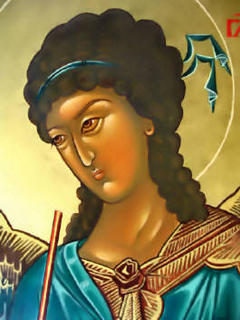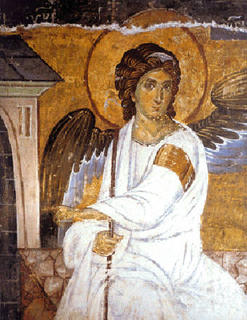![]() |
|
|
found at: http://www.byzantinesacredart.com/gabriel-archangel.html
Archangel Gabriel Orthodox Icon,
Byzantine Iconography

Hand-painted icon by Svetlana Novko©
Egg tempera, 23 Carat gold, natural pigments on woodboard
W14 x H22"
350 x 560 mm
Archangel Gabriel in Scriptures and Holy Tradition, by St. Bishop Nikolai Velimirovich
"The Holy Fathers think that Gabriel has pre-eminence in the first and greatest order of heavenly powers, that is, the Seraphic Order, since the Seraphims stand closest to God. He is, therefore, one of the seven Seraphims, closest to God. The names of the seven are Michael, Gabriel, Raphael, Uriel, Salathiel, Jegudiel, Barachiel. To this number some even add Jeremiel. Each one has their own particular service and all are equal in honor. Why did God not send Michael? Because Michael's service is to suppress the enemies of the Faith of God while Gabriel's is the mission of announcing the salvation of mankind."
Gabriel is the announcer of the Incarnation of the Son of God. He is one of the seven archangels who stand before the Throne of God. He appeared to Zacharias about the birth of the Forerunner. Gabriel said of himself: "I am Gabriel, who stands before God" (St. Luke 1:19). His name Gabriel means "Man - God." The Holy Fathers, in speaking about the Annunciation, interpret that an archangel with such a name was sent to signify who and what He would be like, who must be born of the All-Pure One. Therefore, He will be Man-God, mighty and powerful God. Some of the Fathers understood that this same Gabriel appeared to Joachim and Anna concerning the birth of the Virgin Mary and that Gabriel instructed Moses in the wilderness to write the Book of Genesis.
This great archangel of God is commemorated on March 26th. On this day his appearances and marvels through the whole history of the salvation of mankind are commemorated. It is reckoned that this observance was first instituted on the Holy Mountain in 982, during the patriarchate of Nicolas Chrysoverges (979-91), and was occasioned by the Archangel's appearing in a cell near Karyes, where, with his finger, he wrote the hymn to the Mother of God: "It is meet ... ". As a result of this occurrence, the cell was named, and is called to this day, "It is meet ..."
Linked with this, other appearances of the Archangel Gabriel are commemorated, such as his appearing to Moses when he was keeping Jethro's flocks, when he revealed to this great man, chosen by God, how the world was created and all the rest that Moses later wrote down in the Book of Genesis; his appearing to Daniel and the imparting of the mystery of the kingdoms to come and the coming of the Saviour; his appearing to St. Anna and the promise of a daughter, the most blessed and pure Virgin Mary; his very brief appearing to the holy Virgin while she was living in the Temple in Jerusalem; his appearing to Zacharias the high priest and the news of the birth of John the Forerunner, and the punishing of the same with dumbness because he did not believe the angel's words; his appearing once again to the holy Virgin in Nazareth, and the annunciation of the conception and birth of the Lord Jesus Christ; his appearing to righteous Joseph, to the shepherds near Bethlehem, to the Lord Himself in the Garden of Gethsemane when he strengthened the Lord, as man, before His Passion; his appearing to the myrrh-bearing women, and his other appearances.
Ohrid Prologue
found at: http://www.byzantinesacredart.com/gabriel-archangel.html
The White Angel
(believed to be Gabriel)
found at: http://www.byzantinesacredart.com/white-angel.html
Orthodox Iconography consists of portable/panel icons, frescoes (wall paintings on fresh plaster) and Orthodox mosaics. Some of the greatest, priceless treasures of Byzantine Iconography are adorning the walls of Eastern Orthodox churches in the form of frescoes and mosaics. Among those, Serbian early and medieval fresco painting takes a prominent place.
Built of stone, thousand years old Serbian churches carry some of the most majestic iconographic masterpieces that have, by some art historians, surpassed later Italian Renaissance frescoes in beauty and skill with which they were executed.

White Angel, painted in 1230 at the Mileseva Monastery, Serbia.
Archangel (believed to be Gabriel) at the entrance of Christ's empty tomb, announcing His resurrection to the myrrh-bearing women.
Detail from the Resurrection fresco, Mileseva Monastery, Serbia
Famous Greek Icon Master Photios Kontoglou about Serbian frescoes
"... As far as technical execution is concerned, the wall paintings of Serbia disclose their creators as marvelous masters of the difficult art of wall painting, which in Italian is called fresco, because the artist paints on fresh plaster, put on at the time he is painting, when it is moist and thus retains the paint better. In such painting it is necessary that the painter have complete mastery of his work; he must be able to paint quickly, without hesitation and without making corrections, otherwise the plaster becomes dry, the wall does not absorb the paint, and it flakes off. Then it is necessary to scrape off the plaster, replaster the wall, and start painting again from the beginning.
Now in this work the iconographers of Serbia were great masters, so much so that those who have some conception of the art of fresco painting are astonished. They surpassed many of the Italians who, more than others, worked at frescoes .."
Byzantine Sacred Art
found at: white-angel.html
Other links to Milaseva:
Mileseva - The White Angel (detail)
Mileseva - The White Angel
Mileseva Monastery photo - Alan Grant photos at pbase.com
FUND BLAGO CONTINUES TO FINANCE RESTORATION OF MILESEVA MONASTERY FRESCOES: NEXT, NEMANYICS PROCESSION
|
Found at: http://www.angelicartistry.com/gabriel.htm
I bring to mankind, from God, the Gift of Hope.
It is never too late to ask for Our Lord’s forgiveness and mercy.
Do not despair. Keep hope alive in your heart. Know that you are loved. |
|
|
And now I beseech you not to pray to me, for I am only a messenger of the Lord.
Pray only to God. Love God with all your heart and keep His commandments.
The Archangel Gabriel is called the Angel of the Annunciation because it was he who informed Mary that she had found favor with the Lord and that she would conceive in her womb the Son of God.
The lilies Gabriel carries symbolize the purity of Mary. The Archangel Gabriel also announced to Zacharias that he would have a son born to him who would be John the Baptist.
It was the Archangel Gabriel who inspired Joan of Arc to go to the aid of the King of France.
There is a tradition that Gabriel is the Angel of Birth. It is said that he carefully spends the nine months of the pregnancy watching over each unborn child and instructing that child on the necessary knowledge of Heaven that is an inherent part of all people. Just before birth, though, Gabriel touches each baby on the upper lip to make the child unable to remember all of the information about Heaven until the child returns to the spiritual state at death. The sign of Gabriel’s Touch is the cleft just below the nose.
The Archangel Gabriel
Gabriel is the Governor of Eden, the ruler of the Cherubim.
He is one of the two angels mentioned by name in the Old Testament, along with Michael.
Gabriel is the Angel of the Resurrection and the Angel of Mercy. He rules the first heaven, which is the heaven closest to humankind. Gabriel appeared to Daniel to explain his vision of the fight between the ram and the he-goat (the oracle of the Persians being overthrown by the Greeks). He appeared again to Daniel to tell him of the coming of a messiah. In Jewish legend, it was Gabriel who dealt death and destruction to the sinful cities of Sodom and Gommorah. According to the Talmud (Sanhedrin 95b) it was Gabriel who destroyed the armies of Sennacherib "with a sharpened scythe which had been ready since Creation."
In the Talmud it is also written that Gabriel prevented Queen Vashti from appearing naked before King Ahasuerus and his guests in order to bring about the election of Esther in her lace. Cabalists identify Gabriel as "the man clothed in linen". In Daniel 10-11, this man clothed in linen is helped by Michael. Gabriel is the preceptor angel of Joseph.
In more recent times, Gabriel is named as the angel
who visited Father George Rapp, leader of the 2nd Advent community in New Harmony, Indiana, and left a footprint on a limestone slab preserved in the yard of the Maclure-Owen residence in that city. The poet Longfellow, in his ‘The Golden Legend’, makes Gabriel the angel of the moon who brings man the gift of hope. | Found at: http://www.angelicartistry.com/gabriel.htm
|
| |








